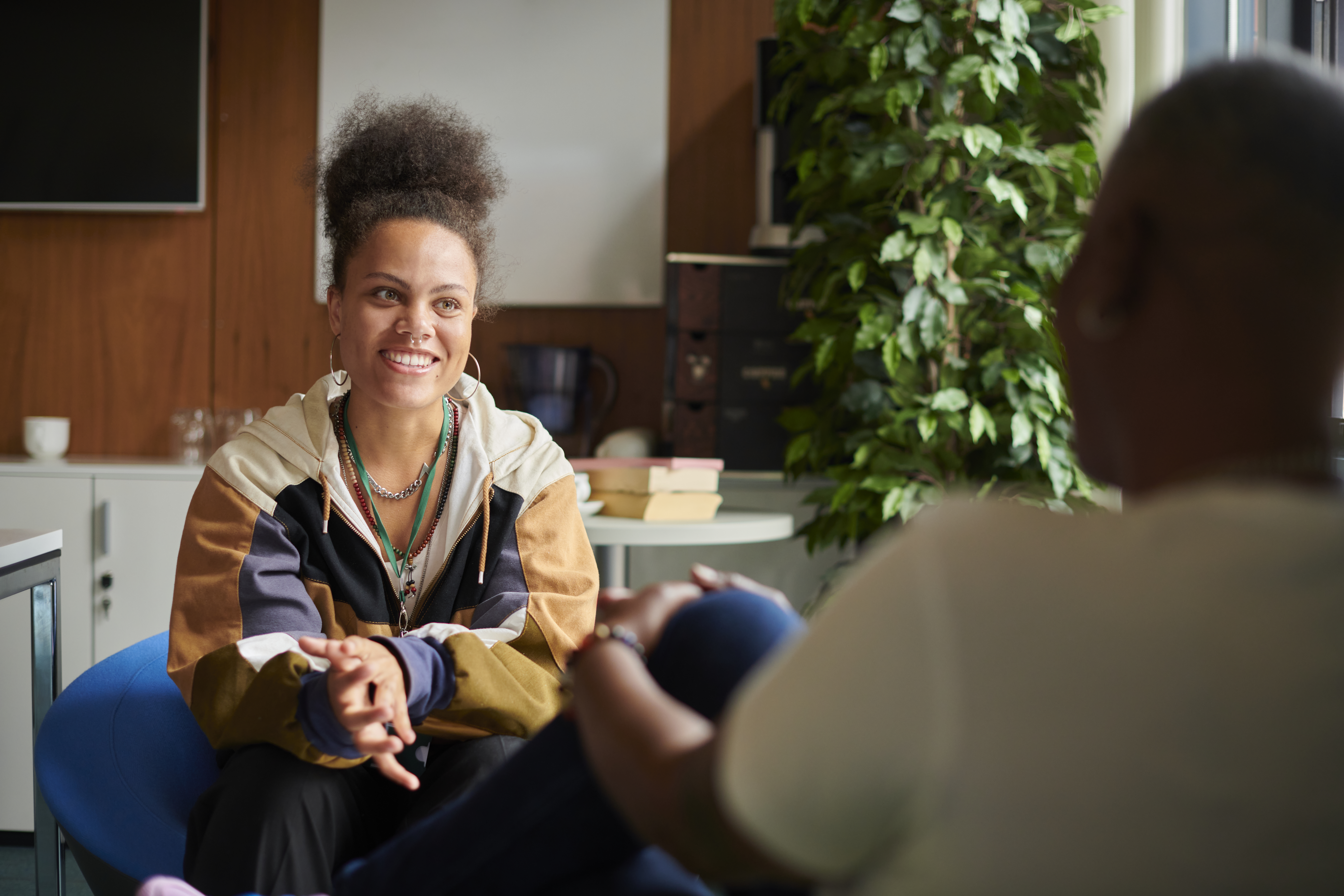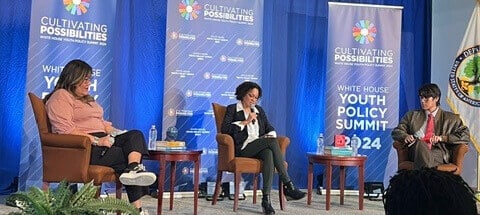Blog
Good Trouble: Flipping the “Troubled Youth” Narrative
“Every young person has that zone of genius,” says Haben Ghebregergish, an educator and the Director of Movement Organizing for Good Trouble, a youth-founded, youth-led, intergenerational movement in the Twin Cities area of Minnesota that is focused on addressing chronic absence, embedding youth voice and prioritizing the needs of young people within the education system.
“Our goal is to make schools motivating and engaging by design, with a goal of school culture outcompeting gang culture,” says Good Trouble’s Chief Troublemaker, Jose Perez. “Only young people can decide what they learn, digest and what resonates with them. The solution we see is centering youth voice in school improvement.”
Good Trouble, co-founded by Jose Perez and Julian Spencer, is focused on elevating and amplifying the voices of youth who are often less engaged in the educational system. The organization aims to cultivate leadership and gather stories and feedback from young people to drive the redesign of schools and educational systems. They collaborate closely with educators, school leaders, and other proactive individuals committed to change. This movement is supported by a team of experts in school evaluation and youth development. Additionally, a diverse group of students, 25 youth "Troublemakers" across three Northside high schools, play a crucial role in guiding the initiative, ensuring that the perspectives and needs of youth are at the forefront of their efforts. These young leaders organize, mobilize, and activate their peers as part of a youth-led movement to redesign schools that work for students.
Jose's challenges with traditional education fueled his drive to reform the education system. As an English learner with dyslexia, he repeated the first and ninth grade and had encounters with the justice system. His father was deported to El Salvador, leaving him to be raised by his single mother, a Guatemalan immigrant. Today, in addition to being a founding member of Good Trouble, he is an R&B artist and a graduate of the High School for Recording Arts in St. Paul.
“It wasn’t until I got my youth developmental needs met in positive spaces and with positive near peers that I was able to be resilient and thrive. Because we had developmental relationships in our lives, we were able to make it ourselves, and lift as we’re climbing,” says Jose. “When we meet the needs of young people’s sense of belonging, real work and purpose, they are able to thrive, even in significant adversity.”
Additionally, practitioner wisdom, collaboration and openness to change is necessary. Good Trouble is focused on centering young people in the process—not as participants, but as co-creators, with youth voice incorporated not only in feedback loops, but in design, implementation, and accountability structures.
Understanding a Strength-Based Approach
The concept of “troubled youth” carries implicit judgment and reduces human beings to one negative characteristic. Young people who encounter this perspective may begin to define themselves as problematic and challenging. A key part of Good Trouble’s strategy is working with young people and ensuring they understand their self-narrative. One way they do that is through experiential learning, such as offsite retreats, where youth reflect on their educational experiences, engage in relationship building activities, learn about youth developmental frameworks, and generate ideas for school improvement—helping them to understand that they aren’t the problem.
“Young people internalize the narrative they are given,” says Jose. “I think Developmental Relationships are core when we think about motivating and engaging schools and getting young people to a place where they can build on their assets. We understand that the first step of learning is authentic connection. It’s fundamental to the whole aspect of learning and making school relevant for young people.”
Noticing and nurturing the best in young people—their talents and strengths—shifts the lens from a deficit view to one that focuses on assets and hope. A focus on youth thriving also requires us to think about the kinds of relationships, experiences, resources, and opportunities young people need in order for their seeds of success to take root and grow.
Good Trouble’s core values are focused on belonging, real work and purpose:
-
Belonging: Being seen, heard, and valued for who you are—when students walk into a classroom and know they don’t have to leave part of themselves at the door. Belonging is the foundation for trust, safety, and motivation.
-
Real Work: Learning that feels relevant, challenging, and connected to a young person’s unique gifts. It’s project-based, hands-on, and rooted in the idea that students want to contribute to something that matters. When learning is real, students rise to the occasion.
-
Purpose: The belief that every young person has a unique gift to give—and that the world desperately needs what they have to offer. When students are aligned with their purpose, school becomes more than a requirement—it becomes a launchpad for their unique gifts.
“In my experience as an educator, relationships often get put last," says Haben. “Especially in places where youth are facing adversity. Often, the focus is on getting test scores up to match other districts, which is important, but as a teacher, I’m challenging you to learn something, and you might not trust me or know if I have your best interests in mind. So that’s where Developmental Relationships really come in. Can we be intentional about building relationships with young people so that they can thrive, particularly youth facing adversity? This is something we have to be intentional about and continue to grow as educators—making relationships foundational to how schools teach.”
A Shift in Perspective
“At the core of this, we help demonstrate that youth aren’t the problem, they are part of the solution. We need active partnership and mentorship and it has to happen with young people. Young people can best articulate their needs. That’s a non-negotiable,” says Jose. “We have to have the people who are instructing and setting policy understand that this is a re-engagement opportunity. We are going to fix it together, rather than waiting for someone to fix it for us. Yes, it’s youth-led, but it’s intergenerational—those closest to the issues and those delivering on the issues working hand in glove.”
“The ultimate goal isn’t to replace experience with youthful ambition, but to blend the two. Imagine what’s possible when we combine the boldness of young leaders with the wisdom of those who have been here before. That’s what TRUE intergenerational leadership, not just lip service, looks like. And this “future” we’re all working towards? It belongs to all of us. Youth don’t inherit the future, we are building it right now.”
-Shaunya Kumar, Student Trouble Maker
“My vision is schools being spaces where there’s co-designing and intergenerational collaboration,” says Haben. “So building the capacity of young people and leaders to understand each other, cooperate and use valuable student insight to shape what their schools are doing.”
A Vehicle for Change
How can leaders and educators reshape this narrative to foster the positive growth of each and every young person? Investing in relationships as a vehicle for change—a vehicle to build each and every young person’s assets—helps to discover and nurture sparks, and makes creating relationship-rich, equitable and inclusive environments a priority. Shifting the perspective from deficit-based to strength-based has the potential to support growth in many ways, including:
- Helping young people discover what they do well and how to develop their talents further.
- Building developmental relationships with each and every young person, forming a web of relationships that connects them with resources and opportunities.
- Seeing youth as resources. Young people bring critical strengths—also known as internal assets—to their own development and contribute to their families and communities.
Noticing and nurturing the best in young people—their talents and strengths—shifts the lens from a deficit view to one that focuses on assets and hope.
“We understand that education is the civil rights movement of our time,” says Jose. “We need to start addressing the core issues. We need schools to be audacious and bold. The time is now.”
This story is part of a Field Partner Spotlight Series focused on highlighting organizations that have embraced and applied Search Institute's frameworks, tools and resources to advance their commitment to support youth thriving.
About Good Trouble
Good Trouble is a youth-led movement to make schools more engaging and motivating than streets and screens. By igniting youth purpose we are reclaiming both democracy and the potential of education. Good Trouble is developing a student feedback tool to lift up what makes school engaging—and call out what doesn’t. This process is youth-designed, youth-led, and youth-facilitated by high schoolers and young people in the Twin Cities.




